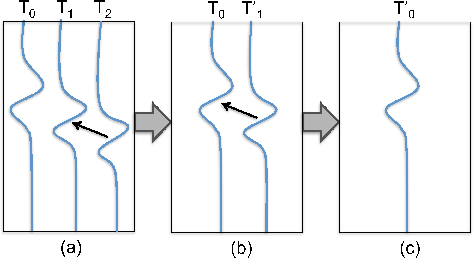|
|
|
|
High-resolution recursive stacking using plane-wave construction |
Next: Examples Up: Regimbal and Fomel: PWC Previous: Introduction
In geophysical estimation problems, regularization is
used to solve ill-posed problems by providing additional constraints on the estimated model.
Shaping regularization (Fomel, 2008,2007) implies a mapping of the input model
 to the space of acceptable functions. The mapping is controlled by the shaping operator
to the space of acceptable functions. The mapping is controlled by the shaping operator
 . In the linear case, the solution of the estimation problem using shaping regularization is defined as:
. In the linear case, the solution of the estimation problem using shaping regularization is defined as:
 is the forward operator,
is the forward operator,
 is the backward operator, and
is the backward operator, and
 is the data. We implement the Generalized Minimum Residual (GMRES) algorithm (Saad and Schultz, 1986) to perform the linear inversion
in equation 1.
is the data. We implement the Generalized Minimum Residual (GMRES) algorithm (Saad and Schultz, 1986) to perform the linear inversion
in equation 1.
Shaping regularization in the application to NMO stack utilizes signal from different offsets
to reconstruct a high resolution stack. The model
 is in this case a seismic trace at zero-offset and the
data
is in this case a seismic trace at zero-offset and the
data
 is a CMP gather. We define the linear operators used in the shaping regularization
scheme as:
is a CMP gather. We define the linear operators used in the shaping regularization
scheme as:
 (forward operator) applies predictive painting (Fomel, 2010) to spread information using a known dip field
and then subsamples in time.
(forward operator) applies predictive painting (Fomel, 2010) to spread information using a known dip field
and then subsamples in time.
 (backward operator) interpolates the data in time to a denser grid and stacks in a recursive fashion using local slopes.
(backward operator) interpolates the data in time to a denser grid and stacks in a recursive fashion using local slopes.
 (shaping operator) is a bandpass filter that controls frequency content.
(shaping operator) is a bandpass filter that controls frequency content.
We implement PWC stacking in the backward operator of shaping regularization which follows local slopes of a CMP gather. The key idea of this stacking procedure is to start at the farthest offset trace of the gather and make a local slope prediction of the preceding trace using PWC (Figure 1a). The partially corrected trace is then stacked with the uncorrected neighbor, which is the input for the next local prediction (Figure 1b). The process is repeated in the offset direction until the zero offset trace is reconstructed (Figure 1c). This recursive stacking approach results in higher resolution stacks compared to conventional NMO and stack. The procedure is equivalent to computing the zero scale of the seislet transform (Fomel and Liu, 2010). Advantages of PWC stacking include eliminating the effects of “NMO stretch" as well as the problem of non-hyperbolic moveout. The approximate inverse of PWC stacking is defined by predictive painting (Fomel, 2010). This algorithm is comprised of two main steps, namely estimating local slopes of seismic events using plane-wave destruction (PWD) (Fomel, 2002) and spreading information from a seed trace inside a volume. In this application, we use the updated model to spread information across the CMP gather using the estimated dip field.

|
|---|
|
schem5
Figure 1. Schematic of the PWC stacking algorithm. (a) Stack far offset trace T  with neighboring trace T with neighboring trace T ,
(b) stack updated trace T' ,
(b) stack updated trace T' with neighboring trace T with neighboring trace T , (c) final accumulated stack. , (c) final accumulated stack.
|
|
|
In PWC stacking, each seismic trace is predicted from its neighbors that are shifted
along the event slopes. Slopes are estimated by PWD, which minimizes the prediction error to estimate optimal slopes.
PWD can be sensitive to conflicting slopes at far offsets of a CMP gather when the dip is large and
cause PWC stacking to fail in characterizing an optimal stack.
To account for this, we first apply a constant velocity NMO correction to the CMP gather, which results in
smoothly varying slopes without crossing events.
We then estimate the moveout  of the corrected seismic events at offset
of the corrected seismic events at offset  as follows:
as follows:
 is the zero offset travel-time,
is the zero offset travel-time,  is the NMO velocity estimated by a conventional method
and
is the NMO velocity estimated by a conventional method
and  is a constant velocity.
Adding the correction factor due to the constant velocity NMO correction from equation 2, the
dip field becomes:
We use this estimated dip as the initial model for PWD.
This dip estimation scheme follows the velocity-dependent formulation of the seislet transform (Liu et al., 2015)
and provides us with a better estimation of the dip field for CMP gathers with large dipping events and conflicting slopes at
far offsets. We implement this dip estimation method to compute the PWC stack in an iterative
fashion while using shaping regularization (equation 1) to yield a high resolution stack.
is a constant velocity.
Adding the correction factor due to the constant velocity NMO correction from equation 2, the
dip field becomes:
We use this estimated dip as the initial model for PWD.
This dip estimation scheme follows the velocity-dependent formulation of the seislet transform (Liu et al., 2015)
and provides us with a better estimation of the dip field for CMP gathers with large dipping events and conflicting slopes at
far offsets. We implement this dip estimation method to compute the PWC stack in an iterative
fashion while using shaping regularization (equation 1) to yield a high resolution stack.